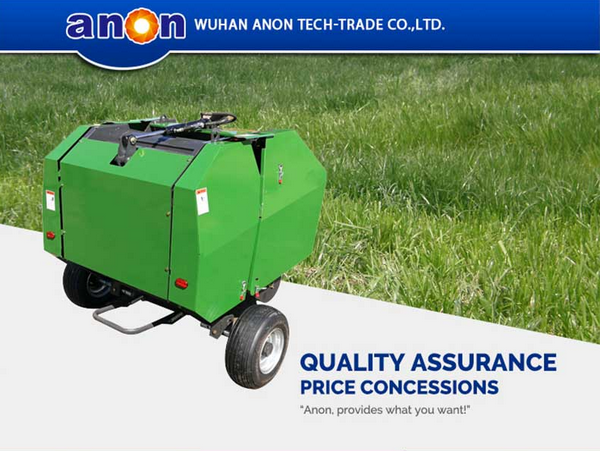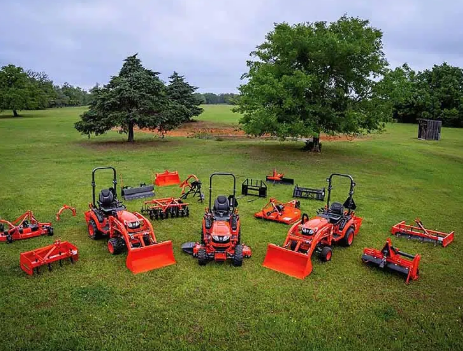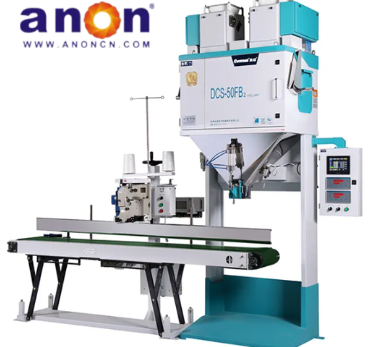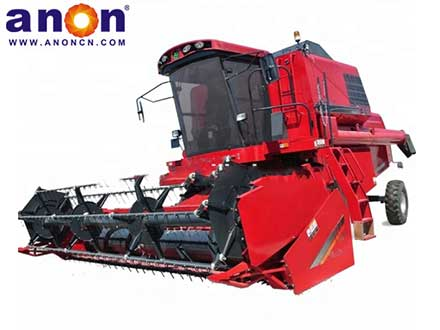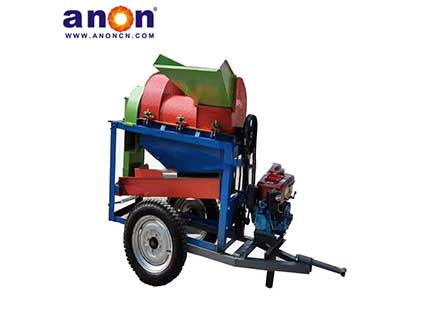Introduction
If you work in agriculture or recycling, you’ve probably heard of balers. But do you really know what they do? How do they work? Understanding balers can help you work more efficiently, save time, and even boost your profits. Today, let’s take a closer look at what balers are all about.
What does a baler machine do?
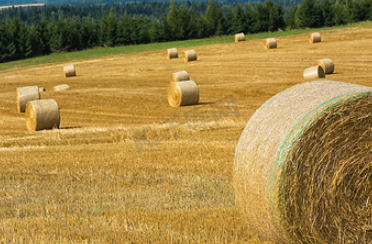
In agriculture, a baler is a machine used to compress and bind loose materials like crop straw and forage into regular-shaped bales. It is widely used in farming and livestock production.
A baler mainly consists of the following parts: a pickup device, a conveying system, a baling chamber (compression chamber), a tying mechanism (binding system), a bale outlet, a power transmission system, a control system, a wrapping device, a chassis, and a hitching mechanism.
The pickup device collects scattered straw or forage from the field and feeds it into the baling chamber. It usually includes tines, a drum, and a guide plate.
The conveying system continuously moves the collected forage into the compression area. It typically consists of rollers, chains, and belts.
The baling chamber (compression chamber) is the core component. It compresses the forage into shape. Round balers use roller or chain-belt types, while square balers use a plunger-type compression system.
The tying mechanism (binding system) wraps and secures the formed bale. It usually uses twine, plastic rope, or net wrap. Some systems include an automatic twine-cutting device.
The bale outlet automatically opens the chamber door and pushes out the bale once it’s formed.
The power transmission system transfers power from the tractor’s PTO (Power Take-Off) to various parts through gears, chains, and belts.
The control system manages the baling rhythm, tying actions, and bale ejection process.
The wrapping device, usually optional, wraps the bale with plastic film after tying to prevent mold and spoilage.
Lastly, the chassis and hitching mechanism connect the baler to the tractor.
Types of baler machines
Common types of balers include round balers, square balers, baler-wrapper combinations, and mini balers.
Round Baler
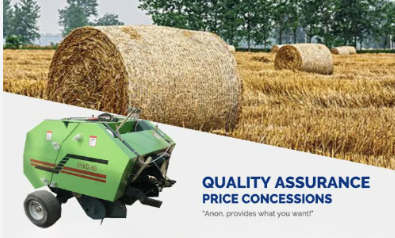
round baler
A round baler is an agricultural machine used to compress and bind materials like crop straw and hay into cylindrical bales. It plays a key role in agricultural production by significantly improving the efficiency of collecting, transporting, and storing straw and forage, while also reducing resource waste.
First, the baler uses a front-mounted pickup to gather loose straw or hay from the field. Then, the conveying system feeds the material into the baling chamber. Inside the chamber, rotating rollers compress the material, gradually forming it into a round bale. When the bale reaches the preset size and density, the baler automatically activates the tying mechanism to secure the bale with twine or plastic netting. The finished bale is then ejected, and the machine begins the next cycle. The bales have a uniform density and good rainproof performance.
A round baler helps quickly complete the processes of picking up, compressing, and tying straw or hay, boosting overall work efficiency. It also has strong adaptability and is less affected by terrain, mainly suitable for operations in areas with complex terrain or steep slopes.
Square Baler
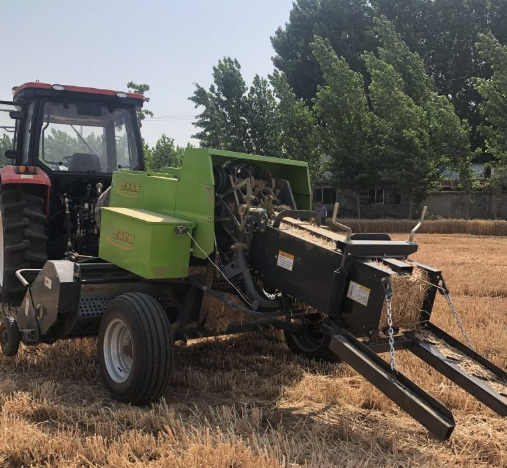
square baler
A square baler is a machine that compresses loose crop straw, hay, and similar materials into rectangular bales. It is typically used in combination with a tractor, which provides the power to drive the baler’s components.
The tractor’s power is transmitted to the pickup device. The rotating pickup gathers straw from the field and lifts it to the feed area. Then, the feeding mechanism moves the material into the compression chamber. Inside, a reciprocating piston compresses the material to a set density. Once the bale reaches the desired size, the tying mechanism activates and secures it with twine or plastic netting. The finished square bale is discharged from the outlet, ready for stacking, transport, and storage.
Square balers are very suitable for crops that require higher density and even stacking, and their complex structure and large volume make them suitable for large-scale operations. They are commonly used in farmland or plain areas with large planting areas.
Baling and wrapping machine
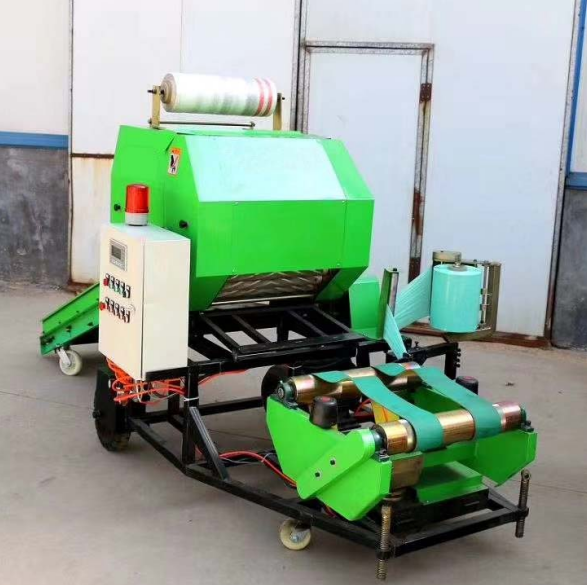
small baling and wrapping machine
Some balers are equipped with a wrapping device, enabling them to perform both baling and wrapping in one integrated process. These baler-wrapper combination machines are especially useful for producing silage and significantly improve the quality and preservation of forage.
The machine compresses the forage tightly to expel air and create an anaerobic environment. This promotes the fermentation of lactic acid bacteria while inhibiting the growth of harmful microorganisms. As a result, the nutritional value of the forage is better preserved.
After wrapping, the forage ferments in a sealed environment, producing beneficial microbes and nutrients. This process keeps the feed fresher, improves its texture and palatability, and helps stimulate livestock’s appetite.
Mini Baler Machine
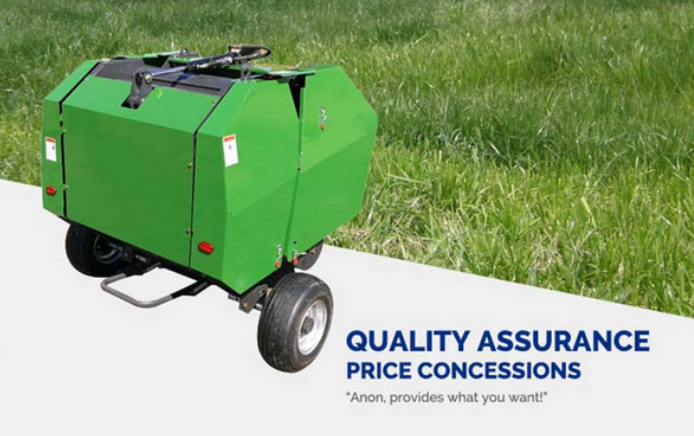
mini baler
A mini baler is a compact, lightweight, and easy-to-operate agricultural machine. It is designed specifically to bale crop residues such as hay, rice straw, wheat straw, and corn stalks into small round or square bales.
Mini balers are typically paired with small tractors ranging from 19 to 50 horsepower. They are especially suitable for hilly areas, mountainous regions, small farms, or family-run farms.
Uses of Baler machines
The baling of hay and silage feed
One of the most common uses of a baler is to bale dry hay or silage forage. Cut and dried hay or grass is baled for use as feed for livestock such as cattle and sheep. Fresh forage can also be baled and wrapped using a matching wrapper to produce silage, which helps preserve nutrients and allows for long-term storage.
The baler compresses the forage into tight, dense bales, reducing the overall volume, preventing mold growth, and extending storage life.
Straw recycling and utilization
The second common application is straw collection and utilization. A baler can pick up straw from crops such as wheat, corn, and rice in the field and compress it into bales, making it easier to transport, store, or sell directly to biomass power plants or feed processing plants.
If not properly managed, these straws can cause problems, as they take up valuable field space and could delay the planting of the next season’s crops. A baler helps quickly and efficiently clear the fields, ensuring smooth and timely land preparation for the next planting season.
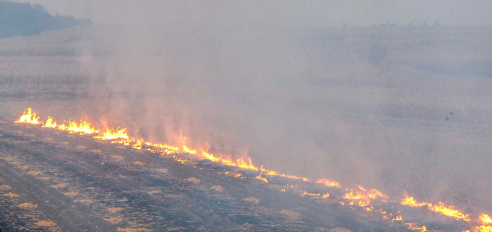
Agricultural waste management
Finally, agricultural waste management is another important application. Balers can be used to bundle various types of recyclable organic materials in agriculture, such as garden waste, dead branches, and leaves, turning them into valuable resources. This helps improve farm hygiene and the overall ecological environment. For example, straw bales can be used as bedding for animals, garden mulch, or for other purposes, promoting the sustainable use of agricultural by-products.
Benefits of Baler machines
Improve working efficiency
A baler allows for quick pickup and baling, compressing large amounts of hay or straw into tightly packed bales in a short period, significantly improving crop processing efficiency. Compared to traditional manual pickup and handling methods, it greatly reduces labor input and lowers physical strain.
One machine can complete straw baling for dozens or even hundreds of acres in a single day. This makes it especially useful during harvest seasons when labor is in short supply.
Promote resource reuse
Baled straw provides convenience for resource utilization. For example, it can be used for biomass power generation, organic fertilizer production, feed processing, papermaking, building materials, and more. This helps achieve the recycling of straw and contributes to increasing farmers’ income.

Easy to transport and store
A baler can bind and compress hay or straw. Compared to loose hay or straw, tightly packed bales are much easier to transport and store. Since the baler significantly reduces the volume of the crop, the space occupied during transportation is much smaller. This reduces the need for storage space and makes the transportation process more efficient. Additionally, it helps save storage space during the subsequent storage phase.
Improving the soil environment
Using a baler to collect and bale straw after harvest effectively addresses the issue of post-harvest straw management. First, the baler collects the straw, preventing the air pollution and soil degradation caused by straw burning. Additionally, the baled straw can be returned to the field, increasing the organic matter content of the soil, improving soil structure, and enhancing soil fertility.
Adapt to various terrains and crops
The baler is highly adaptable and can be used in a variety of terrains, including plains, hills, and mountainous areas. Different models and sizes of balers can be selected based on the specific field conditions. They are suitable for baling straw from various crops such as rice, wheat, corn, hay, and rapeseed.
Common problems and solutions
Baling is not tight or even
During the baling process, issues such as loose or uneven bales may occur. This can be caused by a loose tying system, short twine or film, or uneven moisture content in the forage. In such cases, you should check the tensioner and adjust the tying system parameters to achieve the optimal bale tightness.
Feeding is not smooth
If you notice feeding issues during operation, it may be due to a clogged pickup or a loose or skipping drive chain. In this case, you should stop the machine immediately, clean any foreign objects, and adjust the chain tension until normal operation is restored.
After each work cycle, it’s essential to clean the machine, especially the parts that are prone to accumulating hay, such as the rollers, chains, and shafts. This will help maintain the baler’s performance and extend its lifespan.
Bale falling off or baling failure
If bales fall off or baling fails during the process, you should promptly check if the tying mechanism is damaged or if the sensors are malfunctioning. Replace any faulty parts and ensure the electrical control system is functioning properly. This will help prevent further issues and ensure smooth operation.
The capsule is not tight or is offset
During operation, a baler-wrapper combination machine may experience issues such as loose or misaligned wrapping. This could be caused by improper positioning of the wrapping film or insufficient tension in the film. In this case, you should adjust the wrapping device and check the tensioner to ensure proper film tension and alignment.
Abnormal sound or vibration
Finally, if the baler produces unusual noises or vibrations, it is likely due to bearing wear or loose parts. Therefore, it is important to regularly check and replace bearings, tighten bolts, and use professional lubricants to lubricate the bearings, which will help extend the machine’s lifespan and ensure smooth operation.
How to choose your baler machine?
According to crop type
First, you can choose the baler based on your crop type. If you’re baling light straw crops, like hay or forage, a round baler equipped with a wrapping device would be ideal. For crops like wheat straw or rice straw, either a round baler or a small square baler would work well. At last, if you’re baling tougher materials, such as corn stalks or soybean vines, you’ll need to select a larger square baler or a large round baler to meet your needs.
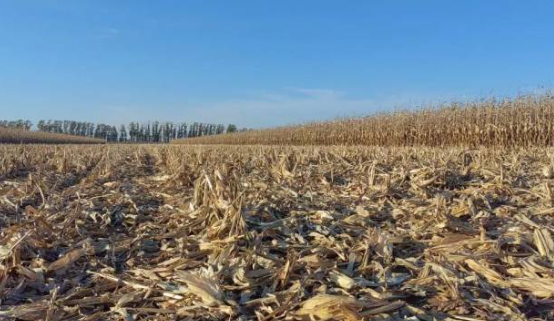
According to your Land
Another consideration is the situation of your land. If it is a hilly area, it is suitable to use a small three-point hanging circular baler. If you want to use it frequently in narrow places, you can choose a rice baler, which is compact and flexible. When your farmland is very flat and endless, you can choose a large baler or a round baler. You can also consider purchasing a corresponding large or small baler based on the size of your farmland.
According to your tractor
Lastly, before choosing a baler, you need to confirm the horsepower of your tractor to ensure that it is compatible with the baler. Square balers usually require more horsepower to operate than circular balers.
Conclusion
The baler is a good helper on our farm. I believe that after reading this article, you have gained some understanding of the baler. If you are interested or feel that it is time to have a baler, please feel free to consult me! We will recommend the most suitable machine for you based on your needs! ANON Agricultural Machinery is here to support your business every step of the way.
FAQ
What is the difference between a baler machine and a compactor?
Balers are used to manage recyclable commodities that are bound for storage and shipping by using baling wire or twine. Compactors are used to reduce the size of the trash, allowing for more waste to be hauled away at a time.
How many square bales per acre?
In general, 100 small square bales per acre is somewhat considered good, although many factors such as location, crop variety, rainfall, and fertilizer all play a part in determining what the actual number will be.
How much horsepower is needed to pull the baler?
If you purchase a baler first, please remember the horsepower requirements when pairing it with a tractor. The PTO horsepower requirement for circular balers starts at 30 horsepower and can reach up to 120 horsepower.


